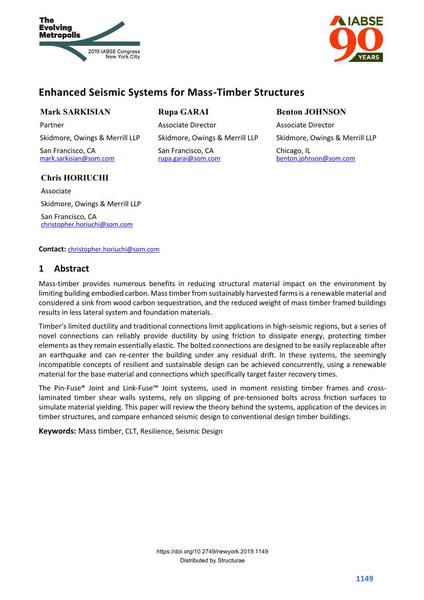Enhanced Seismic Systems for Mass-Timber Structures

|
|
|||||||||||
Bibliographic Details
| Author(s): |
Mark Sarkisian
(Skidmore, Owings & Merrill LLP)
Rupa Garai (Skidmore, Owings & Merrill LLP) Benton Johnson (Skidmore, Owings & Merrill LLP) Chris Horiuchi (Skidmore, Owings & Merrill LLP) |
||||
|---|---|---|---|---|---|
| Medium: | conference paper | ||||
| Language(s): | English | ||||
| Conference: | IABSE Congress: The Evolving Metropolis, New York, NY, USA, 4-6 September 2019 | ||||
| Published in: | The Evolving Metropolis | ||||
|
|||||
| Page(s): | 1149-1155 | ||||
| Total no. of pages: | 7 | ||||
| DOI: | 10.2749/newyork.2019.1149 | ||||
| Abstract: |
Mass-timber provides numerous benefits in reducing structural material impact on the environment by limiting building embodied carbon. Mass timber from sustainably harvested farms is a renewable material and considered a sink from wood carbon sequestration, and the reduced weight of mass timber framed buildings results in less lateral system and foundation materials. Timber’s limited ductility and traditional connections limit applications in high-seismic regions, but a series of novel connections can reliably provide ductility by using friction to dissipate energy, protecting timber elements as they remain essentially elastic. The bolted connections are designed to be easily replaceable after an earthquake and can re-center the building under any residual drift. In these systems, the seemingly incompatible concepts of resilient and sustainable design can be achieved concurrently, using a renewable material for the base material and connections which specifically target faster recovery times. The Pin-Fuse® Joint and Link-Fuse™ Joint systems, used in moment resisting timber frames and cross- laminated timber shear walls systems, rely on slipping of pre-tensioned bolts across friction surfaces to simulate material yielding. This paper will review the theory behind the systems, application of the devices in timber structures, and compare enhanced seismic design to conventional design timber buildings. |
||||
| Keywords: |
seismic design resilience CLT Mass Timber
|
||||
